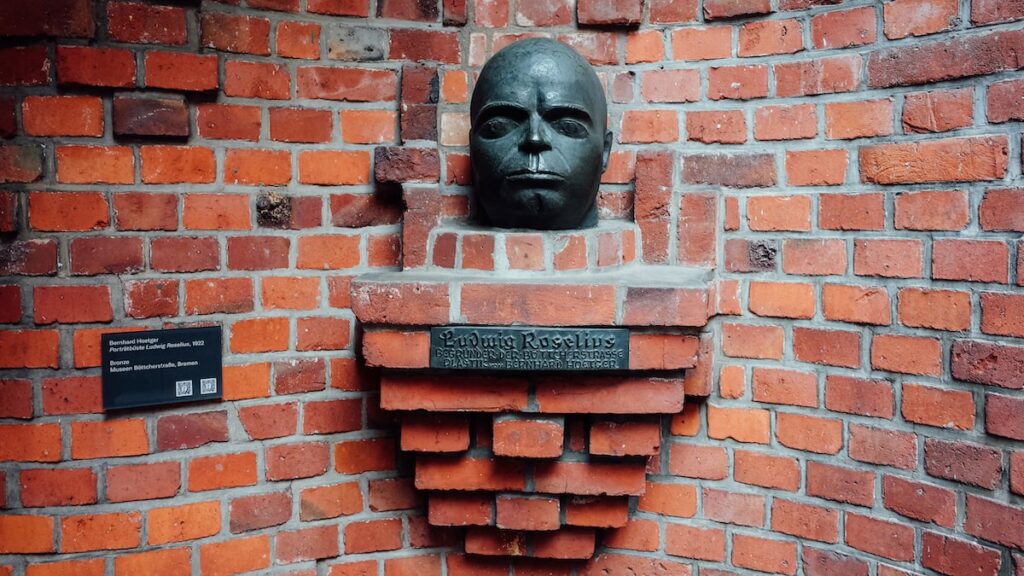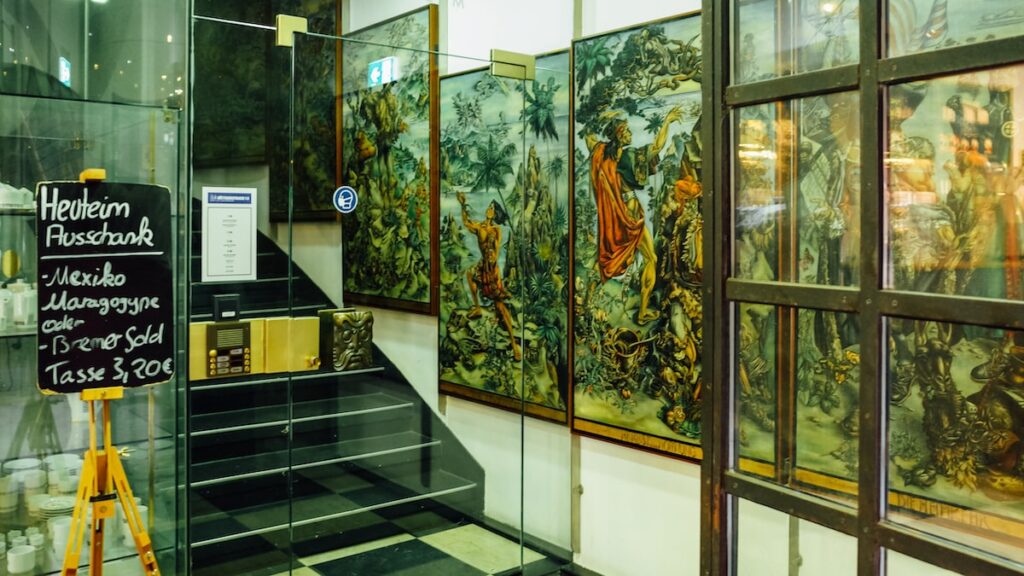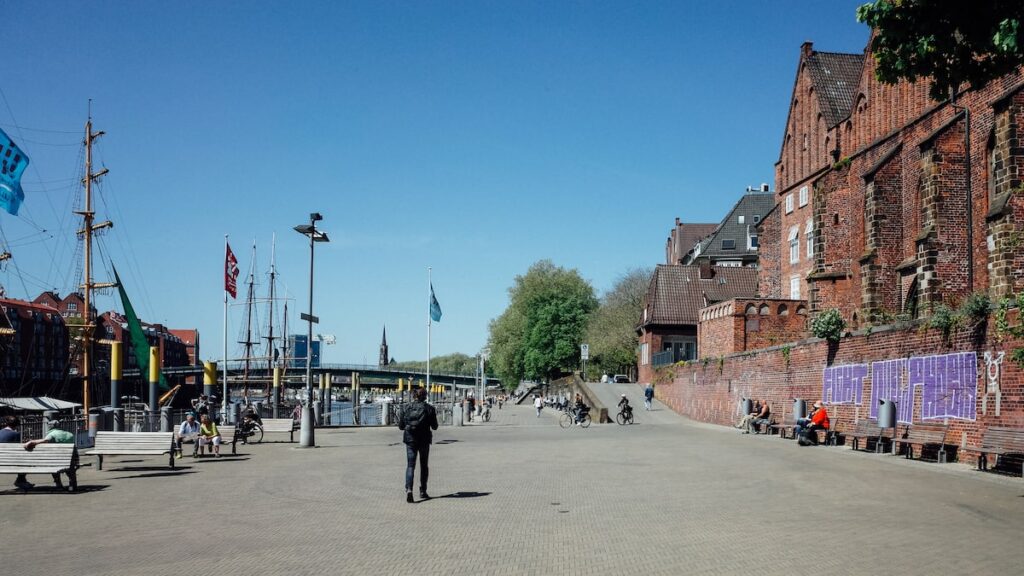Böttcherstraße rightly ranks among the top attractions of Bremen, Germany. Despite being slightly more than 100 meters long (~330 ft), the street owes its fame to the stunning architecture and several important landmarks. Wandering through the Böttcherstraße feels like walking in a city within the city, featuring not just shops and restaurants but also museums and an impressive carillon.
Built back in the 1920s (specifically, between 1922 and 1931), Böttcherstraße is the result of Ludwig Roselius’ vision of the area. The narrow streets and the red brick facades create an exceptional example of expressionist architecture. Additionally, this small street is a vital city artery, connecting the famous Market Square (German: Marktplatz) with the Weser river.
In this article, you’ll find several facts about Böttcherstraße and info about the city. Moreover, you’ll also find a great guided tour to Böttcherstraße and some hotels around the street if you plan to spend a night in Bremen.
So, let’s start with everything you need to know before visiting Böttcherstraße in Bremen.
*Some of the links are affiliate links. It means that if you buy something, I might earn a small commission at no additional cost to you.
Böttcherstraße facts & history

This section deals with the history of the street. You’ll also find various facts about Bremen and the famous Böttcherstraße.
What does the name Böttcherstraße mean?
The name Böttcherstraße refers to the coopers that used to live and work in the street in the 18th century. Böttcher means cooper in German.
However, the street has existed since the Middle Ages. According to historians, in 1317, its name was Hellinchstrate.
Who was Ludwig Roselius?

Ludwig Roselius (1874-1943), the man that envisioned and materialized the Böttcherstraße project, was a German businessman and coffee trader. He is credited as the inventor of decaffeinated coffee. His coffee brand was Kaffee HAG (Kaffee Handels Aktien Gesellschaft), and the company is still in operation.
On the darker side of history, Ludwig Roselius was a Nazi sympathizer who unsuccessfully applied twice for Nazi membership. The rejection was because Hitler considered the art presented in Böttcherstraße as “degenerate art,” an accusation also made against painter Emil Nolde.
How Ludwig Roselius developed the Böttcherstraße?

At the beginning of the 20th century, Ludwig Roselius bought his first building in Böttcherstraße. This happened either in 1902 or 1906 when Roselius looked for a place to base his company. As time went by, Roselius purchased several land plots in the street. After the end of World War I, the first buildings were constructed, and by 1931, the street was concluded.
The project’s supervision was given to Bernhard Hoetger, a German expressionist. On the other hand, the architects that materialized the project were Alfred Runge and Eduard Scotland. The materials used were sandstone and bricks. Due to their distinct style, some buildings are considered outstanding examples of Brick Expressionism.
Which are the most important buildings of Böttcherstraße?
For a 100 meters long street, Böttcherstraße houses many notable buildings. The so-called Böttcherstraße Museums (German: Museen Böttcherstraße) refer to the landmarks and museums on the road. So, here are the must-see spots in Böttcherstraße.
Paula Modersohn-Becker Museum

The Paula Modersohn-Becker Museum is the first museum worldwide dedicated to a female artist. Paula Modersohn-Becker was one of the leading expressionist artists, and the museum at Böttcherstraße houses an eclectic mix of her work.
Despite being one of Germany’s most important cultural institutions, the museum’s story wasn’t always shiny. In 1935 the Nazis attacked the museum, and a year later, Hitler called the art of Böttcherstraße “degenerate art.” Barbara Goette, Roselius’ secretary and companion, defended the work of Modersohn-Becker, but Hitler didn’t change his mind. What she achieved was that the museum wouldn’t have to be destroyed, but Roselius should contribute money to Focke-Wulf, a German manufacturer of civil and military aircraft.
The Ludwig Roselius Museum
Built back in 1588 in impressive Renaissance style, the Ludwig Roselius Museum hosts the private collection of the creator of Böttcherstraße. The collection presents a mixture of items, from furniture and carpets to decorative art. The visitor can also see works by Lucas Cranach the Elder and Tilmann Riemenschneider. The Roselius House is at 6–10 Böttcherstraße and is open Tuesdays to Sundays from 11 am to 6 pm.
The Atlantis House
The Atlantis House is a building based on the idea of Ludwig Roselius and Herman Wirth. Wirth believed that Germans inhabited Atlantis, and that’s how civilization was brought to Egypt and Mesopotamia. Therefore, according to Wirth, the Germans were the oldest race on earth…Oh, well. Despite the not-really convincing idea, the Atlantis House is a modern Art Deco building made of glass and wood, which is pretty unlikely for the Böttcherstraße.
The Atlantis House features a spiral staircase and the so-called Himmelsaal, or Sky Room. The latter has a blue and white ceiling creating an eerie lighting atmosphere. Once again, it was architect Bernhard Hoetger that designed the building.
Nowadays, the building functions as a hotel belonging to Radisson. You can book your room at the Atlantis House here.
Robinson Crusoe House

The Robinson Crusoe Haus completed the construction of the Böttcherstraße. Roselius decided to name the house after the novel by Daniel Defoe. Supposedly, Roselius admired Robinson Crusoe for his Hanseatic spirit.
The house of the seven lazy brothers
The house of the seven lazy brothers (German: Haus der Sieben Faulen) has a much nicer background story. According to the legend, a local farmer had seven sons who couldn’t find a job in Bremen; thus, everybody thought of them as lazy. However, the seven guys escaped Bremen and traveled the world, bringing back new technologies that made life and work in Bremen easier. The shops within the house are beautiful, and so is the fountain of the seven lazy brothers.
Glockenspiel House

The Glockenspiel House is primarily why many travelers visit the Böttcherstraße. The building has 30 bells made of the world-famous Meissen porcelain, and the carillon (German: Glockenspiel) chimes three times a day from January to March and hourly the rest of the year. At the time of the chime, a mechanism inside the building presents figurines dancing on the top, including Christopher Columbus and Charles Lindbergh.
The carillon is at No. 4 of Böttcherstraße.
Are there any elements representing Roselius’ beliefs at Böttcherstraße?

As I already wrote, Roselius was a Nazi sympathizer. For him, the construction of Böttcherstrasse was “an attempt to think in a German way.” The gold relief on the entrance of the Böttcherstrasse ensemble somehow encompasses his faith in National Socialism. The so-called “Lightbringer” (German: Lichtbringer) is a tribute to “our führer over the dark powers.” The relief is square, measuring 3,83 m on each side. However, as you read above, Hitler didn’t have a thing for Expressionism and wasn’t impressed by the compliment. For him, it was degenerate art.
Was the Böttcherstraße destroyed during World War II?
The Böttcherstraße was bombed and severely destroyed in 1944 during World War II. However, Kaffee HAG managed to restore the buildings damaged during WW II, and by 1954 everything was repaired.
To whom belongs the Böttcherstraße today?
Apart from the Atlantis House, the whole Böttcherstraße is owned by Sparkasse Bremen bank.
Böttcherstraße tours and hotels

Böttcherstraße enjoys a fantastic location for exploring the city. It’s just a few meters away from the Marktplatz and equally close to the Schlachte embankment, which is an ideal place for walking by the river. So, in this section, you’ll see where you can stay close to Böttcherstraße and some guided tours that will give you an excellent overview of the area and the city.
The best hotels close to Böttcherstraße
Radisson Blu Hotel Bremen. As already mentioned, the Radisson is the only hotel you can find inside the Böttcherstraße ensemble. It belongs to the Radisson group, and that’s a guarantee for the services offered. The historical building is an architectural gem, and the rooms are wonderful. If you’d like to stay in an iconic spot in Bremen and don’t mind spending some extra cash, look no further. Book a room at Radisson Blu here.
Atlantic Grand Hotel Bremen. The Atlantic (don’t confuse it with Atlantis) is an excellent option for your accommodation in Bremen. It’s a 4-star superior hotel with air-conditioned rooms and coffee-making facilities. It’s just a minute away from the Böttcherstraße and close to the Bremen Town Musicians and the historic Town Hall. Book your room at the Atlantic here.
H+ Hotel Bremen. The H+ Hotel is in Bremen’s Old Town and less than a 3-minutes walk from the Cathedral. The rooms are modern and elegant, and there’s a breakfast buffet every morning. The Schlachte promenade is just a few steps away, and so is the Böttcherstraße. Book your room at H+ Hotel here.
Boutique Hotel Classico. Finally, if you’re after a boutique hotel in Bremen and want a touch of history, the Hotel Classico is for you. That’s a 3-star superior boutique hotel with individually designed rooms. Most of its rooms have a view of the Bremen Rathaus (Town Hall), and the prices include breakfast. See more about the Boutique Hotel Classico.
The best Böttcherstraße tours

There is currently one tour dedicated to Böttcherstraße. However, most walking tours in Bremen will cross the Böttcherstraße too. Therefore, if you’d like to focus on the history of the Böttcherstraße, the first tour is for you. On the other hand, if you’d like to discover the city center of Bremen and get a glimpse of the Böttcherstraße, it’s better to book the second one.
So, the best tours that reach Böttcherstraße are:
Guided walking tour of Böttcherstraße. This is a guided tour dedicated to Böttcherstraße exclusively. Your guide will share plenty of information and background stories about the street and the surrounding area. It costs 15 euros per person and tends to sell out fast. Book the Bottcherstrasse tour here.
Guided tour of Bremen city center. This 2-hour guided tour will take you to every place of interest in downtown Bremen. The Market Place, the Town Musicians, the Schnoor, the Roland statue, and, of course, Böttcherstraße are all part of this tour. It also sells out fast, and it’s a true bargain: it costs 9 euros. Book the city center tour here.
BremenCARD. Last but not least, if you intend to spend a couple of days in Bremen, you can consider the BremenCARD. It offers discounts on the city’s attractions and free use of public transport. It starts from 10,50 euros for 24 hours and is also available for 2, 3, or 4 days. The card is available for individual use or for two persons. Buy the BremenCARD here.
Böttcherstraße: conclusion

Despite its founder’s beliefs, Böttcherstraße is one of the top attractions of Bremen. The architecture is impressive, and there are plenty of museums to discover while strolling around this 100 meters long street. Additionally, this small urban complex features some great cafes and workshops where you can unwind and buy local souvenirs. If you visit Bremen, make sure to wander through Böttcherstraße to get an impression of life and motives that might seem distant but are just a century old.
More Bremen: Discover Schnoor
More Germany: Osnabruck guide, Berlin guide
Pin it for later

Sharing is caring. Share this article about Böttcherstraße, Bremen, with your friends.
Last Updated on October 29, 2022 by George Pavlopoulos

